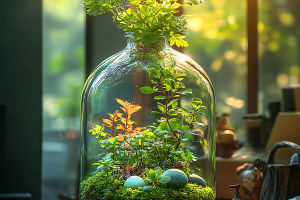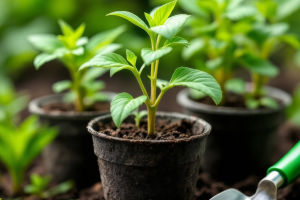Have you ever wondered how plants, though immobile, manage to thrive and outcompete each other for vital resources like light, water, and nutrients? While we often think of competition as a behavior exclusive to animals, plants engage in intense competition in nature as well.
They compete for limited resources in a process that is essential for their survival. In this article, we'll dive into the fascinating ways plants compete with each other and the strategies they use to secure their place in the ecosystem.
The Key Resources Plants Compete For
Plants, like all living organisms, need a few essential resources to survive. The primary resources for plants include:
1. Light: Plants need sunlight for photosynthesis, the process by which they produce energy. As they grow, their need for light becomes more critical, especially in dense environments like forests.
2. Water: Water is another crucial resource for plants, as it is needed for nutrient transport and metabolic processes. In arid regions or places where water is scarce, plants must find clever ways to access and conserve water.
3. Nutrients: Essential nutrients like nitrogen, phosphorus, and potassium are vital for plant growth. These nutrients often exist in limited supply in the soil, making them highly competitive resources.
4. Space: Space is another form of resource that plants compete for. A plant's ability to secure and defend physical space in the soil is essential for rooting, growing, and reproducing.
Each of these resources is essential for plant survival, and competition for them drives many behaviors and interactions in natural ecosystems.
How Plants Compete for Light
Light is perhaps the most visible resource for which plants compete. Trees, shrubs, and other plants that share a common area must fight for access to sunlight. In dense forests, for example, the taller trees with larger canopies naturally block sunlight from reaching the plants below them. As a result, plants growing underneath must adapt or risk being shaded out.
Some plants, like vines, have evolved to climb up taller plants, seeking light by growing upwards. Others, like sunflowers, have developed the ability to track the sun's movement through a process called heliotropism. This allows them to maximize light absorption, giving them an edge over nearby competitors.
On the flip side, certain plants grow in the shade and are adapted to thrive in low light conditions. These shade-tolerant plants can grow at a slower pace, but their strategy allows them to survive in areas where direct sunlight is a rare commodity.
Water Competition in Dry Environments
Water is one of the most important and sometimes scarce resources in nature. Plants living in arid regions or areas with limited rainfall face intense competition for water. In dry climates, deep-rooted plants are often more successful in accessing groundwater, while shallow-rooted plants are left struggling to find moisture near the surface.
Some desert plants, such as cacti, have evolved specialized adaptations like thick, water-storing tissues, allowing them to survive long periods without rain. In contrast, plants in wetland environments often have to compete for water due to the high plant density and often limited space for root growth. In such areas, plants with larger or more complex root systems often have an advantage over smaller plants.
Interestingly, some plants have even evolved "allelopathy"—a strategy where one plant releases chemicals into the soil to inhibit the growth of neighboring plants, giving it better access to water and nutrients. This type of chemical competition allows certain plants to dominate their habitats by limiting competition from other species.
Competition for Nutrients
The soil is filled with a range of nutrients that are vital for plant growth. However, these nutrients are often present in limited quantities, leading to fierce competition among plants for access. One of the key nutrients that plants compete for is nitrogen. Nitrogen is essential for photosynthesis and cell growth, and in nitrogen-poor soils, plants that can access this resource have a clear advantage.
Some plants, like legumes, have developed a unique relationship with nitrogen-fixing bacteria that allow them to convert atmospheric nitrogen into a usable form. This relationship gives them a competitive edge, especially in nutrient-poor soils.
In addition, plants may compete for phosphorus, which is vital for root and flower development, and potassium, which is essential for overall plant health. Plants with more aggressive root systems or greater root mass can absorb these nutrients more effectively, giving them a stronger chance at survival.
Space: The Need for Room to Grow
Space is another essential resource in the plant world. When plants compete for space, it is not just about having enough room to spread their leaves or produce flowers. Space is vital for root growth, which is essential for accessing water and nutrients.
Plants that grow too closely together may not have enough room to spread their roots effectively, leading to stunted growth or even death. Taller plants often shade out smaller plants, while plants with expansive root systems can crowd out others. The competition for space is especially pronounced in environments with high plant density, such as rainforests and meadows.
Survival Strategies: How Plants Adapt
Given the intense competition for resources, plants have evolved various survival strategies to help them secure their place in nature.
1. Fast Growth: Some plants, like annuals, grow quickly, reach maturity, and reproduce in a short period, ensuring they don't get outcompeted by slower-growing species.
2. Efficient Use of Resources: Certain plants, like succulents, are able to store water in their tissues, allowing them to survive in environments where water is scarce.
3. Root Expansion: Many plants, like trees, have large and extensive root systems that can enter deeper into the soil to access water and nutrients that other plants cannot reach.
4. Chemical Competition: Some plants, particularly invasive species, release allelopathic chemicals into the soil to inhibit the growth of nearby plants, reducing competition and increasing their own access to resources.
5. Mutualistic Relationships: In some cases, plants form relationships with fungi, insects, or even other plants to help secure resources. For example, some plants form symbiotic relationships with mycorrhizal fungi to improve their ability to absorb nutrients.
Conclusion: Nature's Balance of Competition
Plants may seem passive, but their competition for resources is a dynamic and often intense process that shapes ecosystems. Whether it's competing for light, water, nutrients, or space, plants have developed a variety of strategies to ensure their survival and dominance. Understanding how plants compete for resources helps us appreciate the complexity of nature and the incredible adaptability of plant life.
The next time you take a walk through a forest, garden, or even your own backyard, take a moment to consider how plants are interacting and competing for resources all around you. It's a fascinating world beneath the surface that plays a key role in shaping the beauty and biodiversity of our planet.


